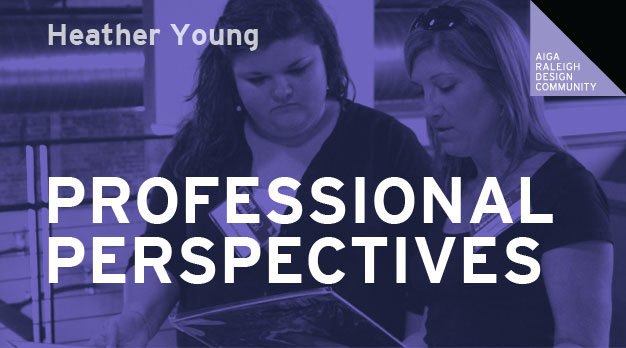
For some of us, designing for the web is that monster under the bed that can cause most of us to push creating an online portfolio to the end of any to do list. However, having an online portfolio has become a must have in the design community. It is a convenient way to share your work with potential employers and clients. Unlike a print portfolio, an online portfolio gives you the capacity, liberty and flexibility to express more of your capabilities as a designer and personality as an individual.
The web may be an uncharted territory, but it should not be scary. Having web knowledge welcomes another arena to create within, and gives you one more skill to add to your resume.
This week Heather Young will make us feel good about the web, by answering some of our questions. Heather is knowledgeable in both web and print, and she is currently a UX Community Manager for Vitamin T.
What is your background in design?
My first job was a Creative Assistant with Gerber Childrenswear in Greenville, South Carolina. I later went on to work for a printing company where I learned about the print process and how to design for print. Later, I became the production manager at a few agencies, and finally moved into the digital space, where I was an interactive designer for over 10 years. Currently, I am the UX Community Manager for Vitamin T, a division of Aquent.
How many AIGA Raleigh Portfolio Reviews have you attended and critiqued?
I have been lucky to be a part of two reviews, and I just signed up for number three.
What are some examples of pieces that should be in a student’s portfolio?
When employers and clients hire you for a design job, they want to know how you go about solving problems. They trust that you can use your skills as a designer to help solve their business problems through a great design.
How many pieces should a strong print portfolio contain?
There’s no magic number, a strong portfolio should have anywhere from 7-12 examples for your best work.
How should I organize the headings on the navigation bar?
This is a great question. When creating your website, think about your audience and anticipate their needs for visiting your site. Follow trends and highlight the type of design work you want to create in the future. You want to include standard heading links like About, Portfolio, and Contact (Me).
Do you feel it is important to link your portfolio to your social media?
I do! You are your brand, and you want to present yourself in a cohesive way, tying all the loose ends together. On that note, ensure your social media content represents you in the best light.
I posted my current projects on my Facebook page, I tweet about them and I have a Behance account, do I need an online portfolio?
That really depends on your goals. If you are more interested in digital, then I’d recommend it.
I am not a web person but I need to create a website, what do I do?
There are many opportunities for the designers to display their work online – Coroflot, Behance, to name a few. Also, utilize your community resources, trade services with a Developer – they can build your site, you can design an identity for them.
What are some easy and affordable hosting sites?
Be choosey when selecting a hosting community. I have not heard great reviews about GoDaddy, they can be complicated to work with, the control panel isn’t user-friendly and transferring can be a hassle. Try HostMonster for everyday work and you can buy your domain name from them. The cost for hosting is about $10 month and a domain name is $13. For real high-end, try Media Temple which is $20 a month (however, they were just bought out by GoDaddy). The one I would recommend is Rackspace. Rackspace has great email integration to Google, Microsoft ect…
What is more important, a web portfolio or a print portfolio?
I suppose that depends on who you ask! Both should reflect your best design work. However, I’d say a web portfolio because it’s easier to share.
With your experience, should a designer know print and web?
A designer should know what’s possible with print and web. Being able to work in both mediums allows a designer to be more marketable.
If there was one thing you could tell someone who is making their first portfolio, what would it be?
Demonstrate your ability to solve business problems. Good design isn’t random, it serves a purpose. Become comfortable with storytelling. Be prepared to walk through the problem, action and results of your work.
Featured Professional:
 Heather Young is the UX Community Manager at Vitamin T, a division of Aquent. With her B.A. in psychology from East Carolina University and over a decade of experience as an Interactive Designer, she is keenly positioned in understanding the digital space. Heather is passionate about user experience design and web standards. She is a member of the Triangle User Experience Association, The Triangle Interactive Marketing Association, LA UX Meet-up and MoDevUX DC.
Heather Young is the UX Community Manager at Vitamin T, a division of Aquent. With her B.A. in psychology from East Carolina University and over a decade of experience as an Interactive Designer, she is keenly positioned in understanding the digital space. Heather is passionate about user experience design and web standards. She is a member of the Triangle User Experience Association, The Triangle Interactive Marketing Association, LA UX Meet-up and MoDevUX DC.
In a previous life, Heather designed for brands such as Gerber, Interpath, Energizer, ABB, Lockheed Martin and the National Institutes of Health. When she’s not busy making matches in the digital space, you’ll find her pumping iron at the gym or walking her 5 lb. papipoo, Biscuit.
Author of this post: Mayshanna Pandora Briscoe is a Freelance Graphic Designer, Mixed Media Artist and Aspiring Blogger. She has a B.A. in International Business and A.A.S. in Advertising and Graphic Design with a Certificate in Web Technology. When she is not in her studio she can be found experimenting with a new recipe, posting pictures of her design life or food on Instagram, or making memories with her fan club (aka her friends, family and dogs).